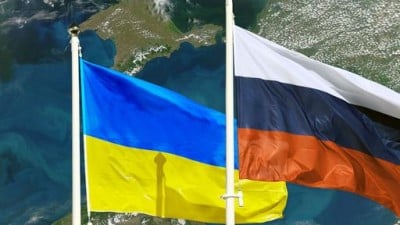Kiev Threatens Russia with a Missile Attack to Distract Ukrainians from the Domestic Situation

All Global Research articles can be read in 51 languages by activating the “Translate Website” drop down menu on the top banner of our home page (Desktop version).
To receive Global Research’s Daily Newsletter (selected articles), click here.
Visit and follow us on Instagram at @crg_globalresearch.
***
Alexey Arestovich, adviser to the head of the President’s Office and a spokesman for the Kiev delegation in the Tripartite Contact Group for Donbass, boldly announced that Ukraine may acquire their own missile system with the potential to strike Moscow. It is expected to have a development time of about 10 years.
It is recalled that Arestovich often makes audacious predictions, such as claiming that Russia would occupy Belarus and that “Poles, the inhabitants of the Baltic states, and with them other Europeans, will suddenly feel that the war (…) is right on their doorstep.” This of course never materialized, but does demonstrate that Arestovich is a populist that makes bombastic rhetoric far removed from reality.
None-the-less, Ukraine has always had potential to develop powerful missile systems. From the famous Soviet defense industry, Ukraine inherited the Yuzhnoy rocket design office in Dnepropetrovsk, the chemical company in Pavlograd, the Kiev-based AGAT design office, and other companies. By inheriting Soviet-era defense industries, the Ukrainian military industrial complex could theoretically develop a missile system of any class. In practice, this will prove much more difficult despite the overconfidence of Arestovich.
Ukraine first decided to develop its own operational tactical system in 1997 by piggybacking off the Borisfen project. The development of Borisfen was probably inspired by Russia’s development of the Iskander missile system. In this period, both countries cooperated and Ukrainian engineers took part in numerous Russian missile projects. By 2007, Ukraine started developments on the Sapsan missile system with a range of 280km. However, in 2013, the Ukrainian Defense Minister Pavlo Lebedyev abolished the development of Sapsan.
Later in the same year, Saudi Arabia was reportedly interested in developing a Grom-2 missile, which was to be developed on the basis of an unrealized Sapsan. In 2016, Ukrainian companies reportedly received foreign funding for this development. Work on the rocket system progressed, and models of the launcher and rockets, as well as the first samples of solid fuel engines, were created. In 2018, Ukraine conducted fire tests of the engine of a new combat ballistic missile. It was expected that testing of the new missile system would be conducted in 2020 or 2021, but thus far Ukraine and Saudi Arabia have not. The transition from the engine and model of the launcher to real combat operability obviously requires more force and resources than originally planned.
Despite this stop and start ambition to have powerful missiles, Arestovich appears confident that future Ukrainian missiles can penetrate Russian air defenses and threaten Moscow. The Grom-2 missile, with an official increased range of 500km, could reach Moscow as eastern Ukraine brings it within range.
The range for the Grom-2 missile could unofficially be over 600km. It may also have the advantages of the Russian Iskander missiles, such as the ability to control the missile along the entire flight path, anti-missile manoeuvring in the final part of the flight, and other perks. This could make it difficult for Russian air defense systems to deal with because Grom-2 was created on the model of low altitude intercontinental missiles.
It is recalled that Russia has in service the S-500 missile defense systems, something not yet available for export and would more than likely be able to deal with any missiles developed by Ukraine. Given Ukraine’s decades long failure to produce an ambitious missile, it leads to the question on whether the current project will be a repeat of all previous attempts, which is a reflection of the failures of the entire Ukrainian military industry as a whole since the collapse of the Soviet Union.
Ukraine is desperate to kickstart its military industrial complex again, and is partially hinging its bets on Turkey to assist in this. Turkey and Ukraine pledged earlier this year to continue their military cooperation, with Turkish drones making their way to the Donbass battlefield. Ukraine will also assist Turkey in creating an engine to finally complete the Turkish-assembled Altay tank and Storm Howitzer that have been plagued with issues since their conceptions.
However, building a tank engine is far different to creating an ambitious missile that can penetrate Russian air defenses and strike Moscow. It is unlikely that Ukraine will be able to create such a missile, especially as it has a development period of 10 years, in which time Russian air defenses would be far more advanced.
It is likely that Arestovich recognizes this fact, but for him it is about spouting out anti-Russian rhetoric in a populist manner to appeal to reactionary elements in Ukraine. Kiev continues to struggle to deal with the economic situation and faces isolation as most of Europe is disinterested in inheriting new issues and differences with Russia. With this in mind, Arestovich attempts to distract Ukrainians from the difficult domestic situation by instigating Russophobia with threats that are unlikely to be realized.
*
Note to readers: Please click the share buttons above or below. Follow us on Instagram, @crg_globalresearch. Forward this article to your email lists. Crosspost on your blog site, internet forums. etc.
Paul Antonopoulos is an independent geopolitical analyst.

